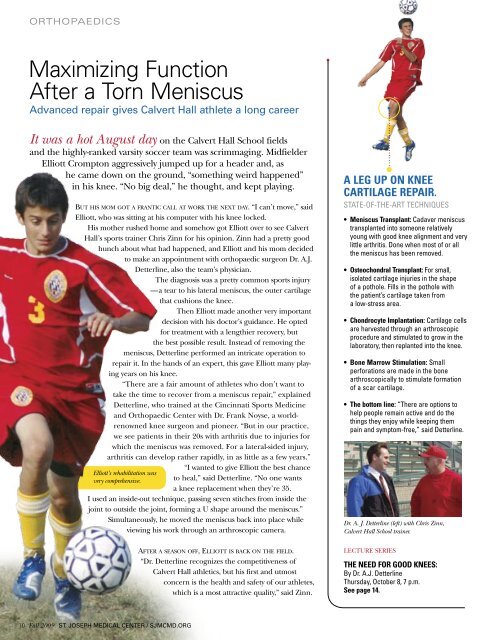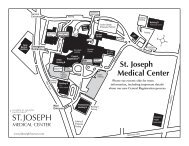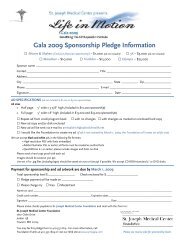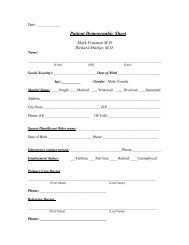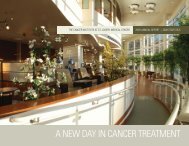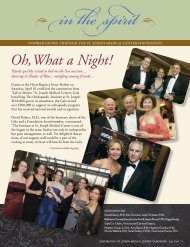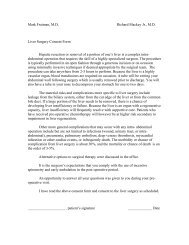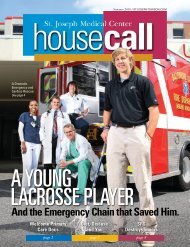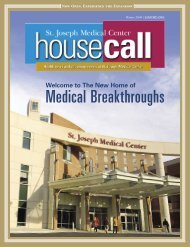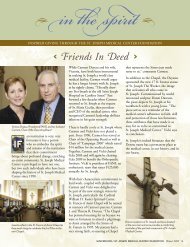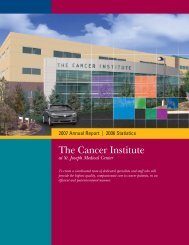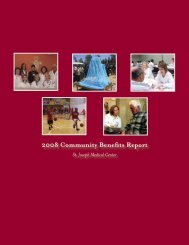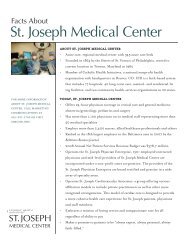Infection Control - St. Joseph Medical Center
Infection Control - St. Joseph Medical Center
Infection Control - St. Joseph Medical Center
Create successful ePaper yourself
Turn your PDF publications into a flip-book with our unique Google optimized e-Paper software.
orthopaedics<br />
Maximizing Function<br />
After a Torn Meniscus<br />
Advanced repair gives Calvert Hall athlete a long career<br />
It was a hot August day on the Calvert Hall School fields<br />
and the highly-ranked varsity soccer team was scrimmaging. Midfielder<br />
Elliott Crompton aggressively jumped up for a header and, as<br />
he came down on the ground, “something weird happened”<br />
in his knee. “No big deal,” he thought, and kept playing.<br />
But his mom got a frantic call at work the next day. “I can’t move,” said<br />
Elliott, who was sitting at his computer with his knee locked.<br />
His mother rushed home and somehow got Elliott over to see Calvert<br />
Hall’s sports trainer Chris Zinn for his opinion. Zinn had a pretty good<br />
hunch about what had happened, and Elliott and his mom decided<br />
to make an appointment with orthopaedic surgeon Dr. A.J.<br />
Detterline, also the team’s physician.<br />
The diagnosis was a pretty common sports injury<br />
—a tear to his lateral meniscus, the outer cartilage<br />
that cushions the knee.<br />
Then Elliott made another very important<br />
decision with his doctor’s guidance. He opted<br />
for treatment with a lengthier recovery, but<br />
the best possible result. Instead of removing the<br />
meniscus, Detterline performed an intricate operation to<br />
repair it. In the hands of an expert, this gave Elliott many playing<br />
years on his knee.<br />
“There are a fair amount of athletes who don’t want to<br />
take the time to recover from a meniscus repair,” explained<br />
Detterline, who trained at the Cincinnati Sports Medicine<br />
and Orthopaedic <strong>Center</strong> with Dr. Frank Noyse, a worldrenowned<br />
knee surgeon and pioneer. “But in our practice,<br />
we see patients in their 20s with arthritis due to injuries for<br />
which the meniscus was removed. For a lateral-sided injury,<br />
arthritis can develop rather rapidly, in as little as a few years.”<br />
Elliott’s rehabilitation was<br />
very comprehensive.<br />
“I wanted to give Elliott the best chance<br />
to heal,” said Detterline. “No one wants<br />
a knee replacement when they’re 35.<br />
I used an inside-out technique, passing seven stitches from inside the<br />
joint to outside the joint, forming a U shape around the meniscus.”<br />
Simultaneously, he moved the meniscus back into place while<br />
viewing his work through an arthroscopic camera.<br />
After a season off, Elliott is back on the field.<br />
“Dr. Detterline recognizes the competitiveness of<br />
Calvert Hall athletics, but his first and utmost<br />
concern is the health and safety of our athletes,<br />
which is a most attractive quality,” said Zinn.<br />
A leg up on knee<br />
Cartilage repair.<br />
<strong>St</strong>ate-of-the-art techniques<br />
• Meniscus Transplant: Cadaver meniscus<br />
transplanted into someone relatively<br />
young with good knee alignment and very<br />
little arthritis. Done when most of or all<br />
the meniscus has been removed.<br />
• Osteochondral Transplant: For small,<br />
isolated cartilage injuries in the shape<br />
of a pothole. Fills in the pothole with<br />
the patient’s cartilage taken from<br />
a low-stress area.<br />
• Chondrocyte Implantation: Cartilage cells<br />
are harvested through an arthroscopic<br />
procedure and stimulated to grow in the<br />
laboratory, then replanted into the knee.<br />
• Bone Marrow <strong>St</strong>imulation: Small<br />
perforations are made in the bone<br />
arthroscopically to stimulate formation<br />
of a scar cartilage.<br />
• The bottom line: “There are options to<br />
help people remain active and do the<br />
things they enjoy while keeping them<br />
pain and symptom-free,” said Detterline.<br />
Dr. A. J. Detterline (left) with Chris Zinn,<br />
Calvert Hall School trainer.<br />
Lecture Series<br />
The Need for Good Knees:<br />
By Dr. A.J. Detterline<br />
Thursday, October 8, 7 p.m.<br />
See page 14.<br />
10 Fall 2009 <strong>St</strong>. <strong>Joseph</strong> <strong>Medical</strong> <strong>Center</strong> / sjmcmd.org


